Are You Ready for Electric Vehicles?
Electric vehicles (EVs) are supposed to be the next big thing. By 2030, half of the U.S. auto market is supposed to be EVs of some sort, with the government proposing to spend more than $75 billion to support these vehicles with charging and buying incentives. But how does this affect parking operations? Should it affect parking operations?
The argument can be made that typically, there isn’t a gas station where you park your current gas-powered vehicle, so why should there be one for an electric vehicle? If you do choose to charge electric vehicles on your university campus, private lot, or city parking lot, what kind of service are you providing? Are you doing Level 1 or Level 2 charging? Are you expecting people to pay for that electricity? How do you collect those fees? These are questions parking operators across the nation will have to start thinking about and addressing fairly quickly.
Parking Operators’ Options
The easy and most economical answer of what to do about EV charging is to do nothing. There isn’t any kind of mandate that says parking operators have to provide EV charging for their customers. An argument can be made that parking providers who don’t provide EV charging options will lose customers to those who do but again, parking operators typically don’t fuel your vehicle as it is so why should the burden be on them to do it now? Alternatively, if your parking operation decides to support charging, do you have enough information up front to make that call? The infrastructure that goes into EV charging is not cheap and, in some situations, not available.
Typically, EV charging only becomes available after major construction is completed with it in mind, often as a way to gain points for LEED construction certifications. In short, a building had to be built to accommodate EV charging.
Another consideration is the type of charging you’ll provide. Are you providing plugs or Level 1 charging or are you providing Level 2 charging? A Level 2 charger takes 220 volts 40 amps per charger to work. A double charger needs two circuits of power for every one charger. You can typically install more Level 1 outlets or convince plugs and have EV owners supply the cord that will charge the car. This is a lot slower of a charge, so a car that would be able to go home with a two-hour charge on a level 2 charger has to have an eight-hour charge on a level 1 charger to get the same effect.
Expectations
Across the campus where I am employed, the typical EV driver lives within a five-mile radius of the campus. These users have come to expect that we will provide charging capabilities for them and rely on EV chargers on campus. However, at some point, we will reach the peak of our ability to provide electric vehicle charging simply because the surrounding campus will not have the electrical infrastructure for us to grow the system. At some point, we simply are going to run out of power.
The point of this article is not to be alarmist or say that EV charging is a bad thing, however, hopefully the reader begins to ask questions and begin to consider what is in place and what you need to provide electric vehicle charging options. There are numerous companies out there that provide drop in place solutions as long as you have the infrastructure to power it. But operators need to find out if that infrastructure is ready to support electric vehicle charging.
stock.adobe.com / chesky



